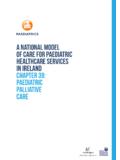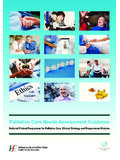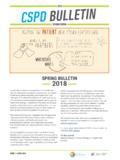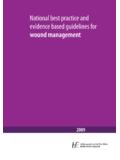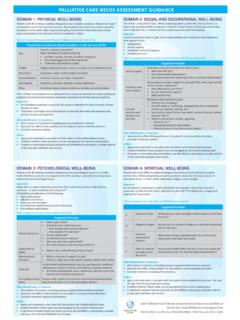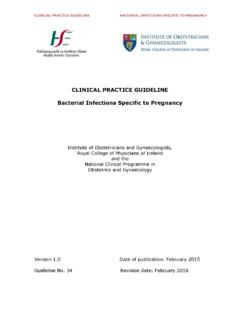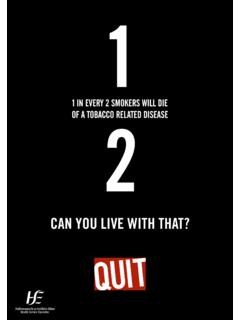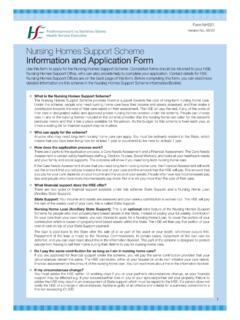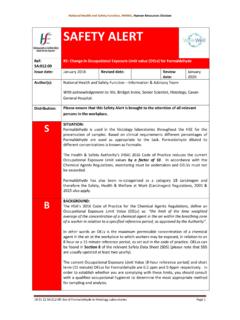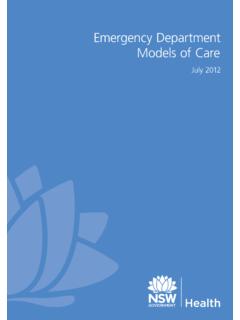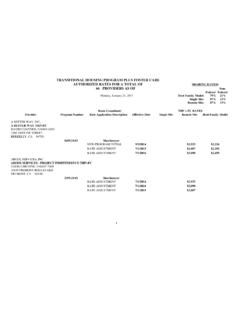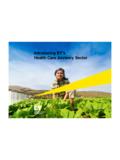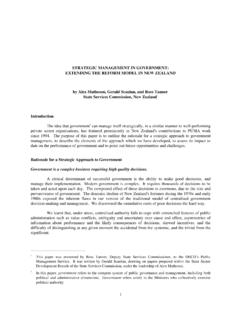Transcription of A National Model of Care for Paediatric Healthcare ...
1 A National Modelof care for PaediatricHealthcare Servicesin IrelandChapter 43:PaediatricRheumatologyClinical Strategy and Programmes DivisionTable of Introduction Current service provision 4 Rheumatology outpatient clinics 4 Current staffing in Crumlin 6 Current staffing in Temple Street 6 Patient journey 7 Interface with primary and secondary care Proposed Model of care 8 Integration of units in Crumlin and Temple Street 8 Hub and spoke Model of care Requirements for successful implementation of Model of care 10 Infrastructure 10 Equipment and technology 10 Human resources 11 Education and training 11 Interdependencies
2 With other clinical programmes Programme metrics and evaluation Key Recommendations Abbreviations and Acronyms References 151national Clinical Programme for Paediatrics and neonatology:a National Model of care for Paediatric Healthcare services in InTroduCTIonThe spectrum of Paediatric rheumatological disorders of childhood are varied and often complex in nature. Recognition of the sub-speciality itself is relatively new to paediatrics, however given its broad base and often multisystem involvement it is frequently at the centre of care in many chronic and acute medical illnesses.
3 A crude overview of the speciality would divide childhood musculoskeletal conditions into inflammatory and non inflammatory Idiopathic Arthritis (JIA) is the commonest inflammatory disorder of childhood and in the Caucasian population has an annual incidence of 1/10,000, and a prevalence of 1:1000 in children less than 16 years of age. There are seven subtypes of JIA of which Oligoarticular JIA is the most frequently seen affecting over 50% of patients. Systemic JIA, which accounts for 10% of the patient cohort, is typically an aggressive subtype of JIA that can prove fatal in some.
4 It is estimated that there are over 1,000 children less than 16 years in ireland with JIA. Uveitis, a potentially sight threatening disease, is the most common extra-articular complication of JIA. It can affect up to 30% of patients, and is typically asymptomatic requiring patients to attend for regular (4-6 monthly) slit lamp examinations. Other inflammatory disorders such as autoinflammatory syndromes or autoimmune/connective tissue disorders (CTD) are less common and often affect multiple systems. They are chronic and potentially life threatening. Many are associated with profound disability in function and mobility.
5 These disorders can impact severely on the education of the children, and on the educational and vocational abilities of young adults/adolescents. The majority of these disorders require immunosuppressant therapy which in itself requires frequent monitoring and recognised and actively managed by the Paediatric rheumatology serviceJIaOligoarticular JIAP olyarticular JIA (RF negative/positive)Systemic JIAE nthesitis-related JIAP soriatic JIAU ndifferentiated JIACTdJuvenile dermatomyositis (JDM)Systemic lupus erythematosusMixed connective tissue diseases (MCTD)Scleroderma systemic and localised/linear morphoeaSjogren s syndromeOverlap CTD2national Clinical Programme for Paediatrics and neonatology.
6 A National Model of care for Paediatric Healthcare services in IrelandVasculitisSystemic vasculitisPolyarteritis nodosaUndifferentiated systemic vasculitis GPA/Wegner s DiseaseBehcet s syndromeAtypical Kawasaki diseaseAtypical Henoch Schonlein purpura Takayasu s arteritis/GCAH ypocomplementemic vasculitis or hypersensitivity vasculitisCerebral vasculitisPost-infectious vasculitissystemicautoinflammatorydisord ersPeriodic fever syndromes (HIDS, PFAPA, CINCA,MWS,FCUS, FMF, TRAPS)Chronic recurrent multifocal osteomyelitisDIRACANDLE syndromereactive (post-infective) arthritisLyme disease with arthritisPost-streptococcal arthritisPost-infectious arthritis Relapsing polychondritisPatients requiring immunosuppressant therapy(under guidance of Rheumatology)Uveitis idiopathic, otherLymphoproliferative diseaseother arthritis associated with systemic diseaseCystic fibrosis-related arthropathyInflammatory bowl-related arthropathiesAnti-phospholipid syndromes Osteoporosis (Idiopathic/Iatrogenic)
7 Genetic syndromes associated with stiff joints, arthralgia, arthritisSkeletal dysplasiaCACP Down s arthropathy/arthritisMetabolic disorders with arthropathyMucopolysaccarodosisHurlersno n-inflammatory disordersBenign hypermobility and hypermobility related to underlying syndromes (Ehlers Danlos Syndrome, Marfan s syndrome, Larsen s syndrome, Sticklers etc.)Pain amplification syndrome / chronic pain syndromeReflex sympathetic dystrophy and complex regional pain syndromesCold-induced injuryOver use syndromes ErythromyelagiaJoint disease associated with other medical conditionsComplex, immunodeficiency, neoplasm, infectious disease, endocrine disorders, genetic, post-transplantation, and arthritis associated with birth defectsTable : Conditions recognised and actively managed by the Paediatric rheumatology service3national Clinical Programme for Paediatrics and neonatology.
8 A National Model of care for Paediatric Healthcare services in IrelandEarly recognition and optimal treatment of JIA is associated with less morbidity and improved outcomes. Arthritis and Musculoskeletal Alliance (ARMA) / British Society of Paediatric and Adolescent Rheumatology (BSPAR) Standards of care for children and young people with JIA (2010) recommends that all patients with suspected JIA should be seen by a Paediatric rheumatologist within six weeks of the referral being made. Standards of care are not currently being met. An audit of services at the National Centre for Paediatric Rheumatology (NCPR) in 2010 confirmed that the majority of the recommended standards are not being fulfilled, including prompt access to subspecialty care and treatment.
9 There was, and continues to be, a delay in access to care , diagnosis and clinical assessment for all patients attending or required to attend this speciality on a National and local level. ireland has one of the lowest levels of consultant to patient ratios in Europe (2nd lowest Paediatric Rheumatology European Society data). There are currently only two Paediatric rheumatology consultant posts in ireland . Guidance extrapolated from the British Society for Rheumatology has recommended one Paediatric rheumatologist to every 200,000 children. It is therefore advised that there should be a minimum of six Paediatric rheumatology consultant posts in ireland .
10 CurrenT serVICe ProVIsIonThe NCPR was established in 2006 in Our Lady s Children s Hospital, Crumlin (Crumlin) with the appointment of ireland s first Paediatric rheumatologist. Prior to this appointment, there was a monthly rheumatology clinic in Crumlin under the care of a general paediatrician. Complex and severe cases were sent overseas to units in the United Kingdom (UK). This National service has grown dramatically with continuous and exponential increase in patient referrals and patient assessments year on year. Patient numbers have increased by almost 400% since 2006.
